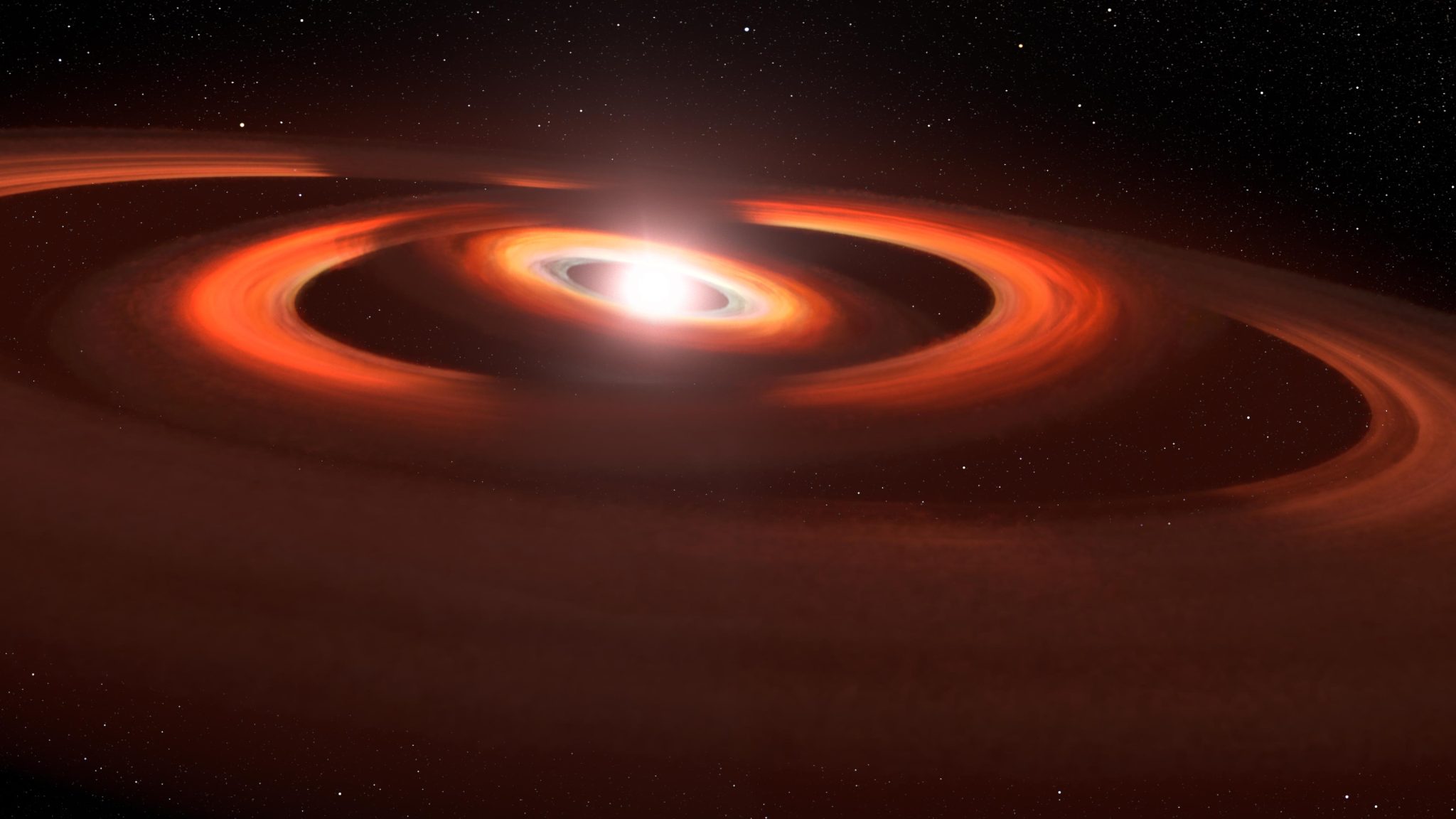
El concepto de este artista se basa en imágenes del telescopio espacial Hubble de discos de gas y polvo alrededor de la joven estrella TW Hydrae. Las imágenes del telescopio espacial Hubble muestran sombras que envuelven los discos que rodean el sistema. La explicación es que estas sombras provienen de discos interiores ligeramente inclinados que impiden que la luz de las estrellas llegue al disco exterior, proyectando así una sombra. Los discos están ligeramente inclinados uno hacia el otro debido a la fuerza gravitacional de los planetas invisibles que distorsionan la estructura del disco. Crédito: NASA, Aura/STScI, Agencia Espacial Europea, Leah Hostack (STScI)
Planetas recién nacidos invisibles levantan polvo alrededor de una estrella joven
Nuestro mundo es tan voluble que a veces le gusta jugar al escondite. En 2017, los astrónomos se sorprendieron al ver una enorme sombra envolviendo un disco de polvo y gas que rodeaba a la joven estrella cercana TW Hydrae. La sombra es proyectada por un disco interior de polvo y gas que está ligeramente inclinado con respecto al plano del disco exterior. La sombra solo se puede ver claramente porque el sistema está inclinado cara a cara en la Tierra, lo que les da a los astrónomos una vista de pájaro del disco mientras la sombra se mueve alrededor del disco como una manecilla que se mueve en un reloj.
Pero el reloj tiene dos manecillas (para las horas y los minutos) que barren a ritmos diferentes. Y resulta que TW Hydrae también lo es. Los astrónomos usaron el Hubble para encontrar una segunda sombra que emergía de otro disco interior, inclinada hacia los dos discos exteriores. Por lo tanto, el sistema parece cada vez más complejo con al menos tres discos superpuestos ligeramente inclinados entre sí. Los discos son representantes de planetas invisibles alrededor de la estrella. Cada planeta atrae material cerca de la estrella con su fuerza gravitatoria y deforma lo que sería un disco en forma de panqueque perfectamente plano si los planetas no estuvieran allí. Esto no es sorprendente porque los planetas de nuestro sistema solar tienen planos orbitales que difieren en inclinación unos pocos grados entre sí. TW Hydrae ofrece a los astrónomos un asiento de primera fila para ver cómo podría haber sido nuestro sistema solar durante sus años de formación.

La comparación de imágenes del telescopio espacial Hubble, que tienen varios años de diferencia, ha revelado dos sombras espeluznantes que se mueven en sentido contrario a las agujas del reloj a través de un disco de gas y polvo que rodea a la joven estrella TW Hydrae. Los discos se inclinan cara a cara en la Tierra, dando así a los astrónomos una vista panorámica de lo que sucede alrededor de la estrella. La foto de la izquierda, tomada en 2016, muestra solo una sombra. [A] Son las 11:00. Esta sombra es proyectada por un disco interior que está ligeramente inclinado hacia el disco exterior y bloquea la luz de las estrellas. La imagen de la izquierda muestra una segunda sombra que ha aparecido de otro disco intermedio. [C] 7:00 a. m., filmada en 2021. Disco interior original marcado [B] en este espectáculo posterior. Las sombras giran alrededor de la estrella a diferentes velocidades, como en el sentido de las agujas del reloj. Son evidencia de dos planetas invisibles que han atraído polvo a sus órbitas. Esto los hace inclinarse ligeramente uno contra el otro. Esta es una imagen de luz visible tomada con el Espectrorradiómetro de Imágenes del Telescopio Espacial. Se ha añadido color sintético para realzar los detalles. Crédito: NASA, ESA, STScI, John Debes (AURA/STScI para ESA), Joseph DePasquale (STScI)
El telescopio espacial Hubble sigue un juego de sombras alrededor del disco de formación de planetas.
La joven estrella TW Hydrae juega a los «títeres de sombras» con los científicos observándolo[{» attribute=»»>NASA’s Hubble Space Telescope.
In 2017, astronomers reported discovering a shadow sweeping across the face of a vast pancake-shaped gas-and-dust disk surrounding the red dwarf star. The shadow isn’t from a planet, but from an inner disk slightly inclined relative to the much larger outer disk – causing it to cast a shadow. One explanation is that an unseen planet’s gravity is pulling dust and gas into the planet’s inclined orbit.
Now, a second shadow – playing a game of peek-a-boo – has emerged in just a few years between observations stored in Hubble’s MAST archive. This could be from yet another disk nestled inside the system. The two disks are likely evidence of a pair of planets under construction.
TW Hydrae is less than 10 million years old and resides about 200 light-years away. In its infancy, our solar system may have resembled the TW Hydrae system, some 4.6 billion years ago. Because the TW Hydrae system is tilted nearly face-on to our view from Earth, it is an optimum target for getting a bull’s-eye-view of a planetary construction yard.
The second shadow was discovered in observations obtained on June 6, 2021, as part of a multi-year program designed to track the shadows in circumstellar disks. John Debes of AURA/STScI for the European Space Agency at the Space Telescope Science Institute in Baltimore, Maryland, compared the TW Hydrae disk to Hubble observations made several years ago.
“We found out that the shadow had done something completely different,” said Debes, who is principal investigator and lead author of the study published in The Astrophysical Journal. “When I first looked at the data, I thought something had gone wrong with the observation because it wasn’t what I was expecting. I was flummoxed at first, and all my collaborators were like: what is going on? We really had to scratch our heads and it took us a while to actually figure out an explanation.”
The best solution the team came up with is that there are two misaligned disks casting shadows. They were so close to each other in the earlier observation they were missed. Over time they’ve now separated and split into two shadows. “We’ve never really seen this before on a protoplanetary disk. It makes the system much more complex than we originally thought,” he said.
The simplest explanation is that the misaligned disks are likely caused by the gravitational pull of two planets in slightly different orbital planes. Hubble is piecing together a holistic view of the architecture of the system.
The disks may be proxies for planets that are lapping each other as they whirl around the star. It’s sort of like spinning two vinyl phonograph records at slightly different speeds. Sometimes labels will match up but then one gets ahead of the other.
“It does suggest that the two planets have to be fairly close to each other. If one was moving much faster than the other, this would have been noticed in earlier observations. It’s like two race cars that are close to each other, but one slowly overtakes and laps the other,” said Debes.
The suspected planets are located in a region roughly the distance of Jupiter from our Sun. And, the shadows complete one rotation around the star about every 15 years – the orbital period that would be expected at that distance from the star.
Also, these two inner disks are inclined about five to seven degrees relative to the plane of the outer disk. This is comparable to the range of orbital inclinations inside our solar system. “This is right in line with typical solar system style architecture,” said Debes.
The outer disk that the shadows are falling on may extend as far as several times the radius of our solar system’s Kuiper belt. This larger disk has a curious gap at twice Pluto’s average distance from the Sun. This might be evidence for a third planet in the system.
Any inner planets would be difficult to detect because their light would be lost in the glare of the star. Also, dust in the system would dim their reflected light. ESA’s Gaia space observatory may be able to measure a wobble in the star if Jupiter-mass planets are tugging on it, but this would take years given the long orbital periods.
The TW Hydrae data are from Hubble’s Space Telescope Imaging Spectrograph. The James Webb Space Telescope’s infrared vision may also be able to show the shadows in more detail.
Reference: “The Surprising Evolution of the Shadow on the TW Hya Disk” by John Debes, Rebecca Nealon, Richard Alexander, Alycia J. Weinberger, Schuyler Grace Wolff, Dean Hines, Joel Kastner, Hannah Jang-Condell, Christophe Pinte, Peter Plavchan and Laurent Pueyo, 4 May 2023, The Astrophysical Journal.
DOI: 10.3847/1538-4357/acbdf1
The Hubble Space Telescope is a project of international cooperation between NASA and ESA. NASA’s Goddard Space Flight Center in Greenbelt, Maryland, manages the telescope. The Space Telescope Science Institute (STScI) in Baltimore conducts Hubble science operations. STScI is operated for NASA by the Association of Universities for Research in Astronomy, in Washington, D.C.





More Stories
¿Cómo se hicieron los agujeros negros tan grandes y rápidos? La respuesta está en la oscuridad.
Una vaca marina prehistórica fue devorada por un cocodrilo y un tiburón, según los fósiles
El lanzamiento del cohete Falcon 9 de SpaceX se ha detenido a medida que se acercan dos importantes misiones de vuelos espaciales tripulados.